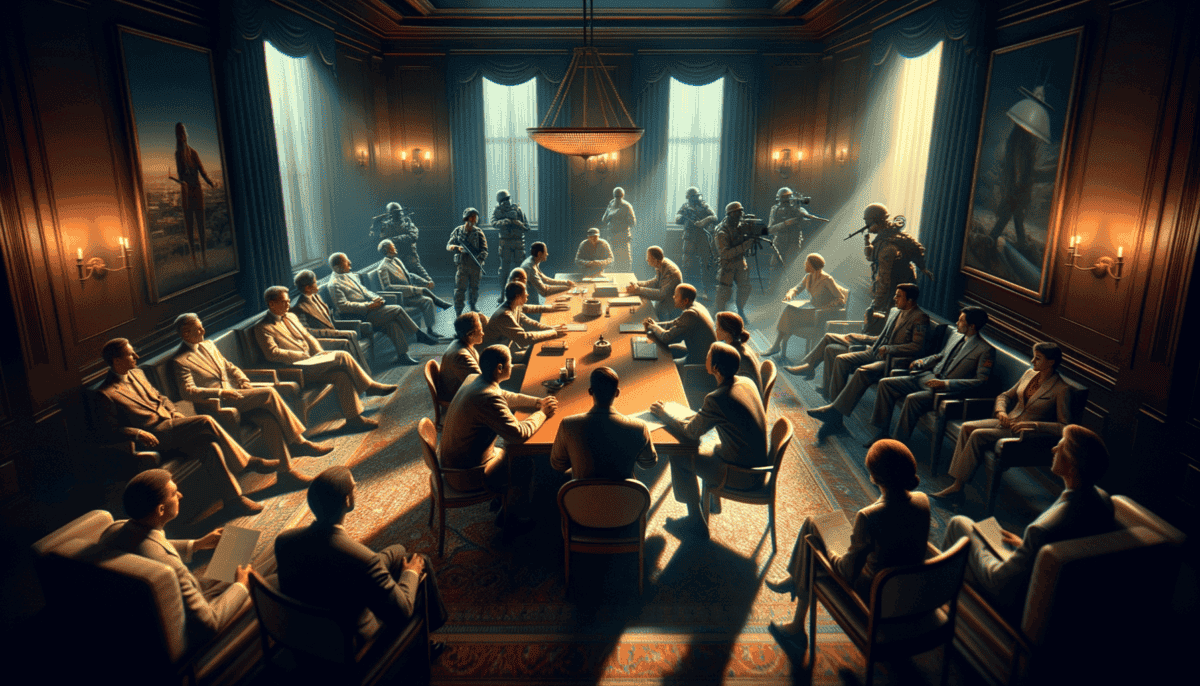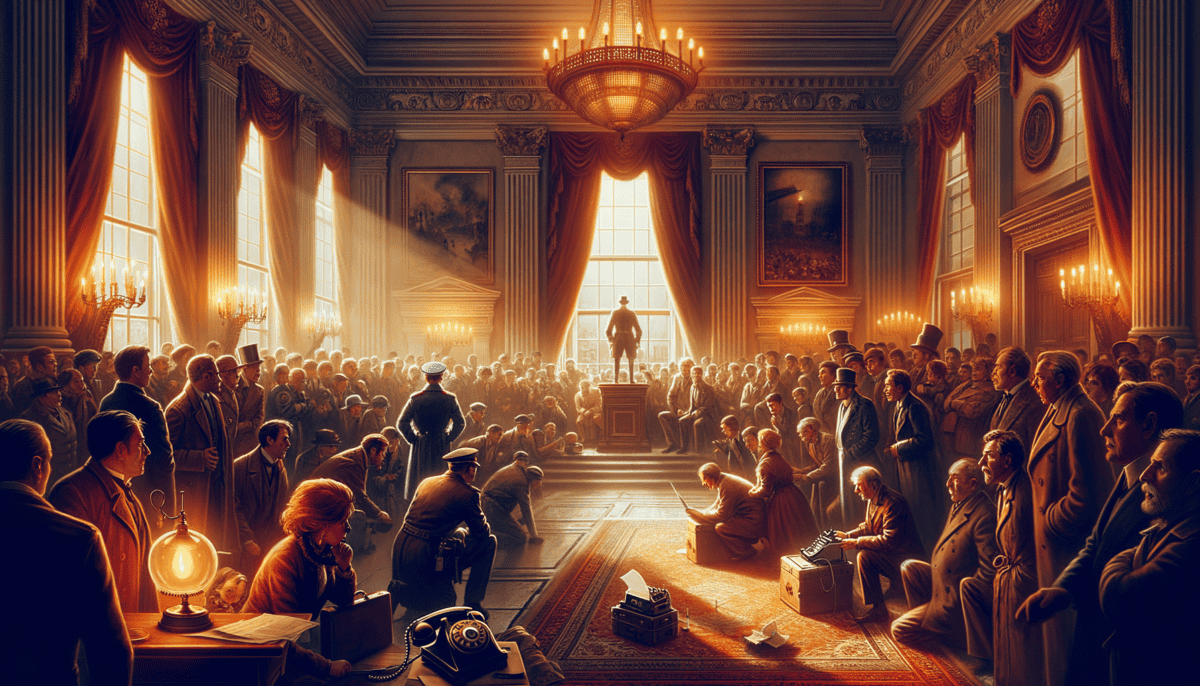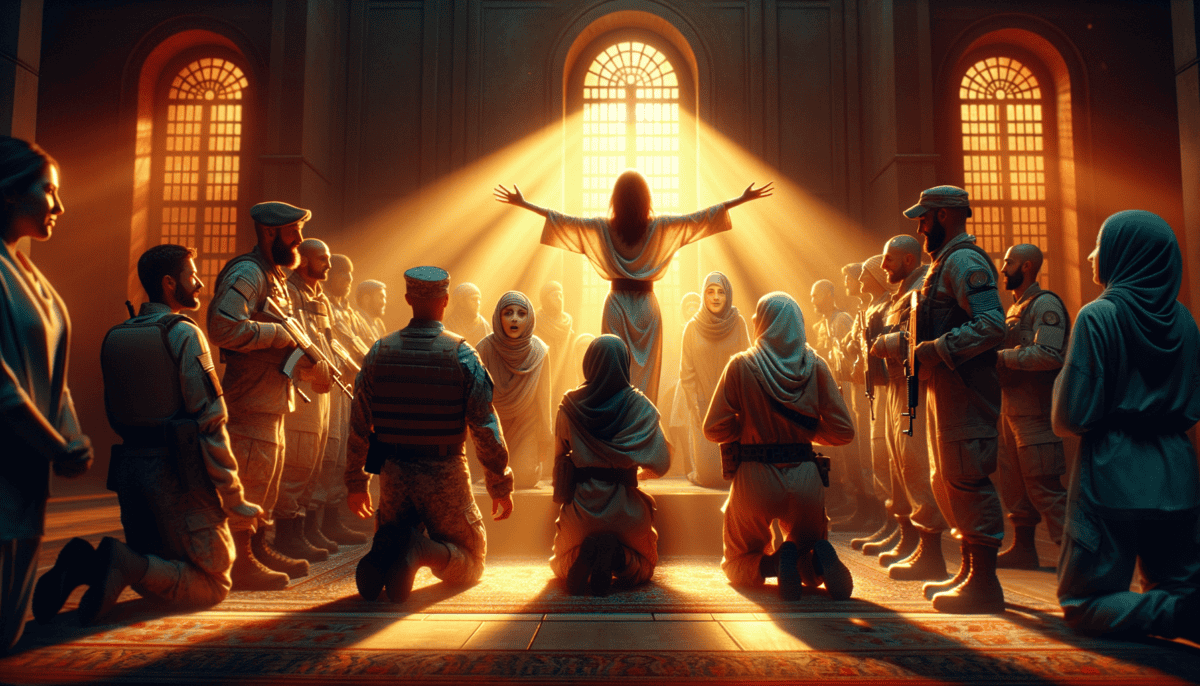Revolution’s Spark
The streets of Tehran buzzed with energy on a cool morning in 1979. Students crowded the sidewalks, their voices filled with excitement and worry. Change was coming to Iran, and everyone could feel it.
Sarah Thompson, a young American teacher at the U.S. Embassy school, watched the growing crowds from her classroom window. Her students seemed different today – more distracted than usual.
"Miss Thompson, why are there so many people outside?" asked Ali, one of her brightest students.
"Big changes are happening in our country," Sarah explained simply. "Some people want Iran to be very different than it is now."
A New Leader Rises
A man named Ayatollah Khomeini had returned to Iran after many years away. He wore black robes and had a long white beard. Many Iranians saw him as their new leader. They were tired of the old ruler, called the Shah, who had left Iran earlier that year.
“The people want freedom!” shouted voices in the streets. “America must stop controlling our country!”
Sarah noticed more angry signs appearing outside the embassy gates each day. The metal bars that once seemed so strong now felt less safe. ️
Growing Tensions
Jake Miller, a young embassy guard, tried to keep everyone calm. "We've seen protests before," he would say with a smile. But even Jake's usual cheerfulness seemed forced now.
The embassy staff started taking new safety steps:
• Shredding important papers
• Moving valuable items to safer places
• Planning escape routes
• Making emergency contact lists
• Practicing safety drills
Warning Signs
By October 1979, the mood had grown darker. Iranian college students gathered near the embassy almost every day. They carried signs and chanted words that made Sarah's heart beat faster.
"I don't like this," whispered Maria Rodriguez, the embassy's communication officer, during lunch one day. "Something feels different."
David Brooks, the senior diplomat, tried to reassure his staff. "We've been through tough times before. This too shall pass." But even David kept looking nervously at the crowds outside.
The Final Days of Peace
On November 3rd, Sarah watched Iranian students pass out leaflets near the embassy. Their faces showed determination. The air felt heavy with possibility – like the moment before a storm breaks. ️
That evening, embassy workers sent messages to Washington about their concerns. But no one knew just how much everything would change the very next day.
Jake stood at his post near the main gate, watching the sun set over Tehran. The city lights began to twinkle on, one by one. Tomorrow would bring a new day – and with it, events that would shock the world.
In her apartment that night, Sarah wrote in her diary: "Something big is coming. I can feel it in the air. I hope we're ready for whatever tomorrow brings."
The streets grew quiet as night fell over Tehran. But beneath the calm surface, a revolution was about to explode into life, changing everything forever.
The Day Everything Changed
The morning of November 4, 1979, started like any other day at the U.S. Embassy in Tehran. But by sunrise, hundreds of Iranian students had gathered outside the gates. Their angry voices grew louder with each passing minute.
The Storm Breaks
Jake Miller stood at his guard post, watching the crowd grow larger. His radio crackled with worried voices.
“They’re climbing the walls!” someone shouted through the static. “Lock down! Lock down!”
Sarah Thompson rushed her students into the embassy’s safe room. “Everything will be okay,” she told them, trying to keep her voice steady. But her hands were shaking.
Breaking Through
The sound of breaking glass filled the air. Iranian students poured through windows and over walls. They carried signs and shouted in both English and Farsi.
“We want the Shah!” they demanded. “Give him back to face justice!”
David Brooks, the senior diplomat, tried to stay calm as he spoke into the emergency phone to Washington:
“This is different from previous protests. They’re inside the compound. We need immediate assistance.” His words were cut short as the phone lines went dead. ☎️
The Capture
The students moved quickly through the embassy buildings. They found Americans hiding in offices and meeting rooms. One by one, they gathered them together.
Maria Rodriguez watched from behind a filing cabinet as her coworkers were led away. She quickly destroyed important documents, following their emergency plans:
• Burn classified papers
• Delete computer files
• Hide or destroy communication equipment
• Protect sensitive information
• Keep calm and follow safety procedures
Heroes in the Chaos
Not everyone was captured right away. Some embassy workers helped others escape:
“Quick, through here!” whispered Bob Anders, showing six colleagues a hidden exit. These brave people would later become known as the “Canadian Six” after finding shelter at the Canadian Embassy. ♂️
A World Watches
News of the takeover spread fast. TV stations around the world showed pictures of the embassy under siege. President Jimmy Carter sat in the White House, worried about his captured citizens.
“We must get our people back,” he said to his advisors. “But we must be smart about it.”
The First Night
As darkness fell over Tehran, the captured Americans found themselves in a frightening new reality. The students blindfolded them and led them to different rooms.
Sarah tried to comfort a younger staff member. “Stay strong,” she whispered. “Help will come.”
Outside the embassy walls, crowds celebrated in the streets. Inside, the hostages listened to the sounds and wondered what would happen next.
Jake Miller, now a hostage himself, remembered his training: stay calm, don’t resist, wait for help. But as he sat in the darkness, he wondered how long they would have to wait.
The world held its breath as a new crisis began. No one knew it would last 444 days, testing the courage and patience of everyone involved.
Life Behind the Walls
The days inside the captured embassy turned into weeks. For the 52 American hostages, each day brought new challenges. The morning sun barely reached through the covered windows where they were held.
Daily Routines
Sarah Thompson marked another day on her hidden calendar. She used a small piece of paper tucked inside her shoe. Twenty-eight marks now. She whispered to herself, “One day at a time.”
Jake Miller developed a daily exercise routine in his small room:
“Ten pushups, ten situps, walk in circles for five minutes. It keeps my body and mind strong,” he told his fellow hostage, David.
Secret Messages
The hostages found clever ways to communicate with each other. They tapped on pipes using a simple code:
• One tap = "Are you okay?"
• Two taps = "Yes"
• Three taps = "Need help"
• Four taps = "Guard coming"
Friendly Guards
Not all the Iranian students were cruel. Maria noticed one young guard, Ali, who sometimes snuck them extra food or blankets.
“My mother would be ashamed if I didn’t show kindness,” Ali whispered one day while bringing her a warm cup of tea.
Small Acts of Resistance
The hostages found quiet ways to keep their spirits up. Bob Anders taught others to play chess using pieces made from bread dough. Sarah organized silent prayer meetings.
News from Home
Sometimes the guards showed them newspapers. The hostages saw pictures of yellow ribbons tied around trees back home. Americans hadn’t forgotten them! ️
“Look,” David pointed to a photo, “My hometown held a candlelight vigil.”
Hard Times
Some days were harder than others. Christmas came and went. The hostages made simple decorations from scraps of paper. They sang carols very quietly.
“Silent night,” they whispered together, holding hands in the darkness. “Holy night.”
Medical Challenges
When people got sick, Dr. Thompson, one of the hostages, did his best to help. He used the limited medical supplies the guards provided.
“Deep breaths,” he would say, checking on his patients. “Stay strong. We’ll get through this.”
Finding Strength
Jake started telling stories at night. He remembered books he had read and movies he had seen. Other hostages shared their own stories too.
Maria taught Spanish to anyone who wanted to learn. “When we get home,” she said, “you can all visit me in Texas and speak Spanish with my family.”
Watching and Waiting
Through small cracks in the window coverings, they could sometimes see the city of Tehran. Life went on outside while they waited.
“Someone will come for us,” Sarah said each night before sleeping. “We just have to stay strong until then.”
As winter settled over Tehran, the hostages huddled closer together. They didn’t know that back in Washington, plans were already being made to bring them home.
Operation Eagle Claw
The White House glowed softly in the dark April night. President Jimmy Carter hadn’t slept much lately. He studied the rescue plan one more time. America needed to bring its people home.
A Bold Plan
“We’re going to rescue our people,” President Carter told his team. The plan had a special name – Operation Eagle Claw. Eight helicopters would fly into Iran at night.
Desert One
On April 24, 1980, the rescue mission began. The helicopters took off as the sun set. They flew low over the desert to stay hidden.
“Weather report shows sandstorms ahead,” the radio crackled. The pilots gripped their controls tighter.
The team reached their first stop – a secret spot in the desert called Desert One. But things started to go wrong.
Everything Goes Wrong
Three helicopters had problems:
• One got lost in the sandstorm
• Another had engine trouble
• The third couldn't fly anymore
“We need six helicopters to rescue the hostages,” Colonel Beckwith said sadly. “We only have five that work.”
The Accident
As the teams prepared to leave Desert One, something terrible happened. A helicopter crashed into a plane!
“Get everyone out!” someone shouted. Eight brave American soldiers died that night.
Back in Washington
President Carter got the bad news in the middle of the night. He went to his office and cried.
“I take full responsibility,” he told the American people the next day. “We will find another way to bring our people home.”
New Plans
The failed rescue made America try harder to find peaceful ways to free the hostages. They started talking more with other countries who could help.
“Sometimes the best way to solve a problem is to talk it out,” Secretary of State Cyrus Vance said.
Hope Stays Alive
Back in Tehran, the hostages didn’t know about the rescue attempt. They kept hoping and waiting.
Sarah Thompson looked out her window at night. “Someone’s trying to help us,” she whispered. “I can feel it.”
Learning from Mistakes
The military learned important lessons from Operation Eagle Claw. They made changes to do better in the future.
Working Together
Countries like Algeria offered to help talk with Iran. They wanted to find a peaceful way to end the crisis.
“We must keep trying,” President Carter said. “Every day, every hour, until our people come home.”
As spring turned to summer, American diplomats worked harder than ever. They wouldn’t give up until every hostage was free.
Waiting and Hoping
The summer heat in Tehran was harsh. Inside the embassy, Sarah Thompson marked another day on her hidden calendar. It had been 250 days since their capture.
Daily Life
“Same bland rice again,” Mike whispered to Sarah during lunch. The hostages ate what their guards gave them, but they missed home cooking.
Letters from Home
A guard walked in with a stack of letters. Everyone’s hearts jumped. Mail from home was rare and precious.
“Dear Sarah,” she read her mother’s words quietly. “We think about you every day. Stay strong. America hasn’t forgotten you.”
Tears rolled down her cheeks as she hugged the letter close.
News from Outside
Sometimes the guards let them watch TV. They saw how Americans tied yellow ribbons around trees to remember them.
“Look how many ribbons!” Tom pointed at the screen. “The whole country is waiting for us.”
Making Friends
Not all the guards were mean. One young guard named Ali would sometimes share his candy with them.
“My mother makes these,” Ali said one day, passing out sweet dates. “She says everyone should eat well, even…”
He didn’t finish his sentence, but Sarah understood. Even prisoners deserved kindness.
Helping Each Other
The hostages became like family. They told stories, played word games, and kept each other’s spirits up.
• Sharing memories of home
• Teaching each other new skills
• Making up silly songs
• Exercising together when allowed
Secret Messages
They found clever ways to pass messages between rooms. Tapping on walls became their secret language.
“Three taps means I’m okay,” Sarah taught new hostages. “Four means I need help.”
Hope Grows
Word spread that Algeria was helping America talk to Iran. Maybe freedom wasn’t far away!
“My guard seemed happier today,” Mike said one evening. “Something good must be happening.”
Special Moments
They celebrated birthdays with extra bread saved from meals. Christmas came and went. They sang carols quietly in their rooms.
“Silent night,” they hummed together, “holy night…”
Getting Stronger
Each day made them stronger. They learned patience. They found courage they didn’t know they had.
Change in the Air
As 1980 came to an end, something felt different. The guards whispered more. They seemed excited about something.
“Maybe we’ll be home soon,” Sarah thought as she watched the winter sun set over Tehran. “Maybe tomorrow will be the day.” ⭐
Freedom at Last
The morning of January 20, 1981, started like any other day in Tehran. But something was different. The guards were rushing around, talking fast in Persian.
The Big News
Sarah’s heart jumped when her door swung open. A guard with a big smile said, “Pack your things. You’re going home!”
Getting Ready
Everyone packed quickly. They didn’t have much – just worn clothes and precious letters from home. Sarah held her hidden calendar tight. It showed all the days she’d been brave.
“Is this really happening?” Mike asked, his voice shaking with joy.
“Yes,” Sarah smiled. “We’re going home!”
The Journey Home
They walked into the bright sunlight. Big planes waited to take them away from Iran. The American flag on the planes never looked so beautiful.
“I never want to forget this moment,” Tom whispered as they climbed aboard.
Happy Tears
As the plane took off, many cried happy tears. They were leaving Iran behind. Freedom felt like a warm hug. ✈️
“Look!” Sarah pointed out the window. “We’re really flying home!”
Welcome Home
When they landed in America, crowds were waiting. People waved flags and yellow ribbons. Everyone cheered for the brave hostages.
• “America’s Heroes!”
• “We Never Forgot You”
• “Welcome Back Home”
• “God Bless Our Hostages”
Family Reunions
Sarah ran to hug her mom and dad. They held each other tight, crying happy tears.
“We missed you so much,” her mom said.
“I missed you too,” Sarah whispered. “Every single day.”
Moving Forward
The hostages were free, but their story wasn’t over. They had to learn how to live normal lives again. Some things were hard, but they helped each other.
Lessons Learned
The Iran Hostage Crisis changed America. It showed how strong people can be when times are tough. It taught us to never give up hope.
A New Chapter
Today, the old embassy in Tehran still stands. It reminds us of those 444 days. But it also shows us that even the hardest times can end with hope.
The hostages proved that courage comes in many forms. Sometimes it’s just getting through one more day. Sometimes it’s keeping hope alive when things seem dark.
Their story teaches us that freedom is precious. It shows us that together, we can get through anything. And most importantly, it reminds us that hope never dies.






